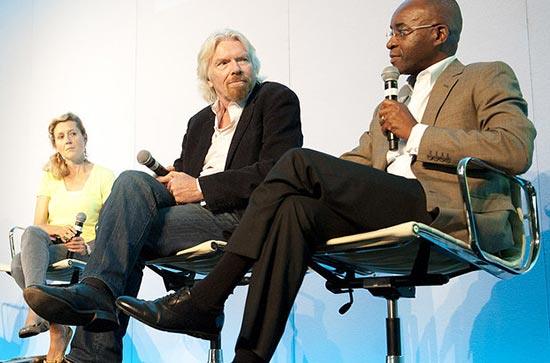



Virgin Group founder Richard Branson and Econet Wireless founder Strive Masiyiwa.
By Strive Masiyiwa and Richard Branson
DESPITE impressive economic development in recent years, Africa still lags far behind on energy, with almost two-thirds of the continent’s citizens lacking access to electricity.
While getting more power to the people is an important goal, extending electricity grids is expensive and slow.
Meanwhile, off-grid options may not be sufficient to meet people’s energy needs.
Fortunately, there is a third approach that can help fill in the gaps: Mini-grids.
Mini-grids are essentially localised electricity networks that supply several users, whether households or businesses.
They can be grid-connected, but they do not have to be.
And, as a new report from the Africa Progress Panel (of which one of the authors is a member) shows — and as another report by the Rocky Mountain Institute underscores — mini-grids are an important piece of Africa’s energy puzzle.
Mini-grids can have a major competitive advantage over grid extension in rural and remote areas, because they can provide electricity more quickly and at much lower cost.
Because mini-grids require less capital investment than grid expansion, it can be easier to secure financing for them, meaning that they can electrify communities that might have to wait years for a grid connection.
Mini-grids also have a distinct advantage over off-grid systems: greater power generation.
Productivity-enhancing farm machinery, for example, usually requires more power than off-grid household systems can provide.
Moreover, mini-grids can be used to increase the resilience of existing electricity systems. Power cuts on the main grid can affect a large number of businesses and households, and it can be difficult to restore services quickly.
Mini-grids can ensure that consumers retain access to power when the grid suffers interruptions.
Despite these benefits, the potential of mini-grids to help address Africa’s energy challenge has yet to be tapped.
Reliance on mini-grids is expanding more slowly than in other world regions, with Africa being more likely to implement off-grid systems.
One obstacle is the lack of proven commercial business models and adequate and appropriate forms of financing.
Another is that policy frameworks often are not accommodating.
And many developers and operators lack the requisite knowledge and experience.
The situation is ripe for change.
With the United Nations sustainable development agenda ambitiously targeting universal access to energy by 2030, policymakers are paying more attention to electrification, and development-finance institutions and partners are making more funding available.
Meanwhile, the cost of renewable energy is falling; energy efficiency is improving, both for generating equipment and for the machines to be powered; and innovative digital technologies are facilitating the management of electricity services.
A flexible solution like mini-grids is well suited to this context.
As it stands, mini-grids in Africa are mostly diesel or hydropower systems.
Yet mini-grids can — and increasingly do — take the form of solar PV and hybrid systems, with hybrid systems being particularly promising.
Diesel systems face the risk of fuel-supply disruptions or cost increases, while renewable-energy generation can vary according to weather and season.
Hybrid systems that combine diesel with solar or wind power mitigate these risks.
Mini-grids are flexible in other ways, too. Mini-grids may or may not be connected to the national grid.
They can be operated privately, by utilities, on a community basis, or according to a public-private model.
And they can sell electricity to retail consumers, utilities, or both.
So how can African governments use the potential of mini-grids to help expand energy access?
As recent experience in the United States has shown, early adoption of technical innovations, particularly of digital management tools, could enable mini-grid business models to become more cost-efficient.
New technologies could even enable mini-grid providers to develop entirely new organisational models for electricity systems that are more effective and resilient than the conventional utility-based approach.
Experience in the US, as well as in Asia, also underscores the importance of favourable government policy and regulations, including capital subsidies.
The challenge, of course, will be for each African government to design a mini-grid strategy around the options and models that work locally.
That means setting appropriate tariffs and establishing a coherent framework of technical, financial, and procedural regulations.
It also requires building up the necessary skills and capacities in the labour force.
In developing their electricity systems, most African countries will have to consider and combine many different models and options. For many, mini-grids can play an important role.
If African governments embrace diversity in the way electricity is generated and distributed, they could provide modern energy to millions of people, while placing the continent at the forefront of a global energy transformation. — Project Syndicate
Strive Masiyiwa is a member of the Africa Progress Panel and founder and chairman of Econet Wireless. He is also the co-chairperson of GROW Africa and chairman of the board of the Alliance for a Green Revolution in Africa. Richard Branson is the founder of the Virgin Group, an investor and philanthropist.
